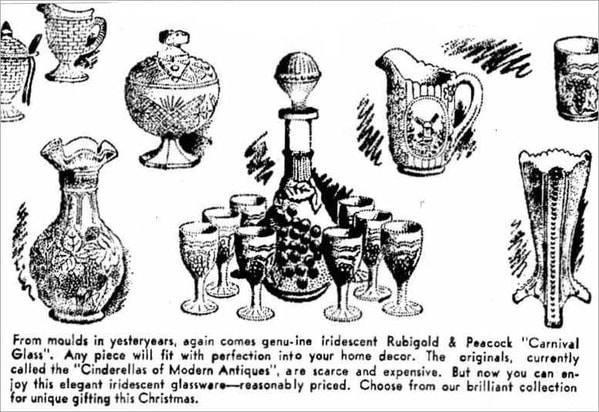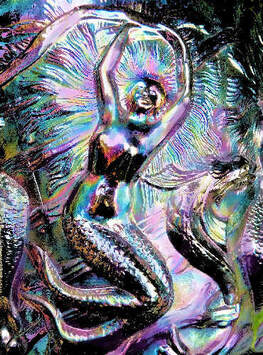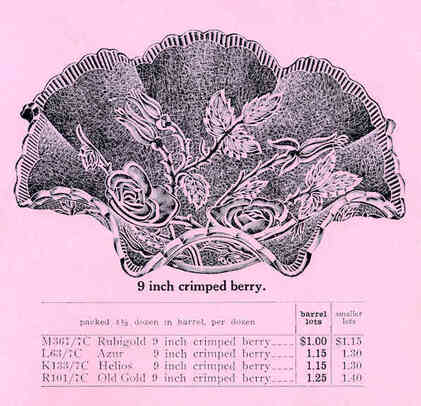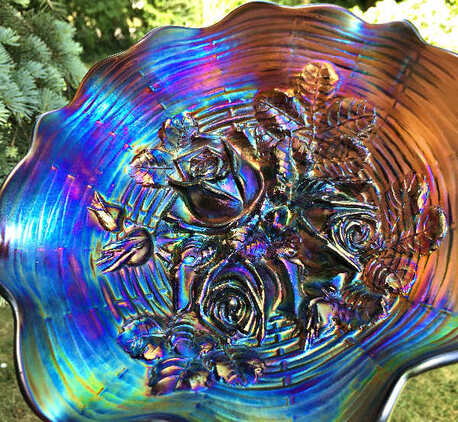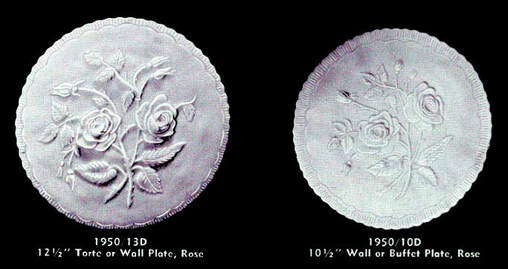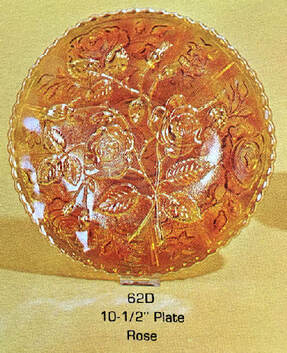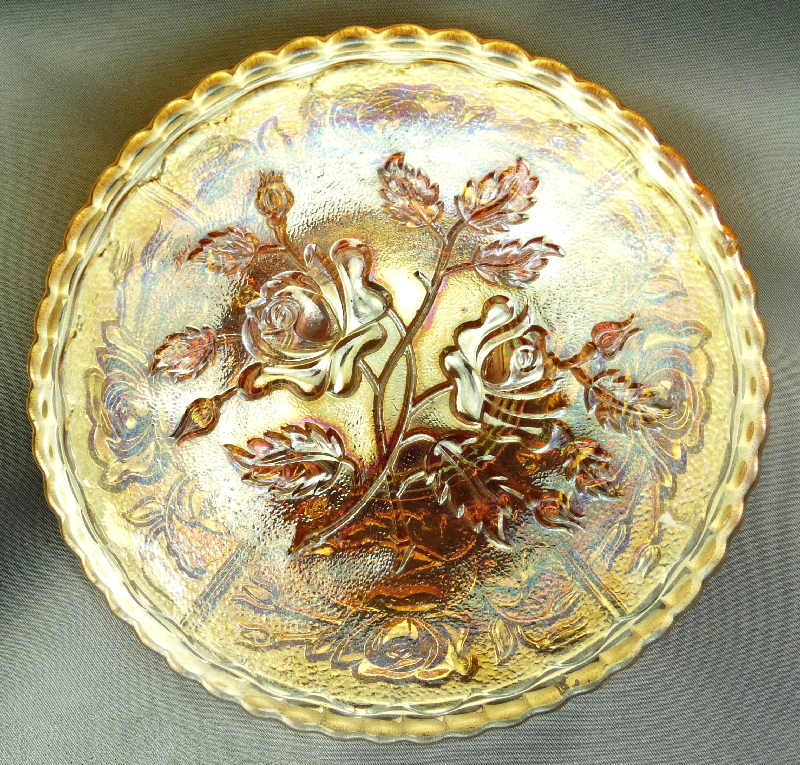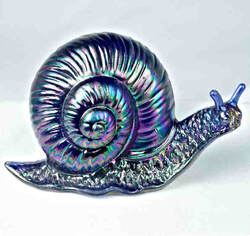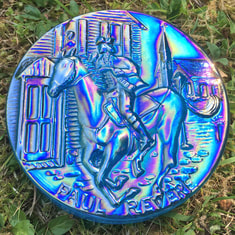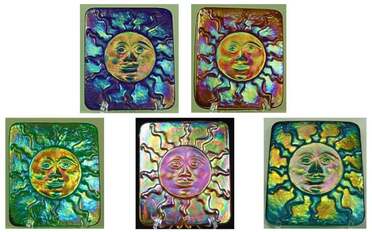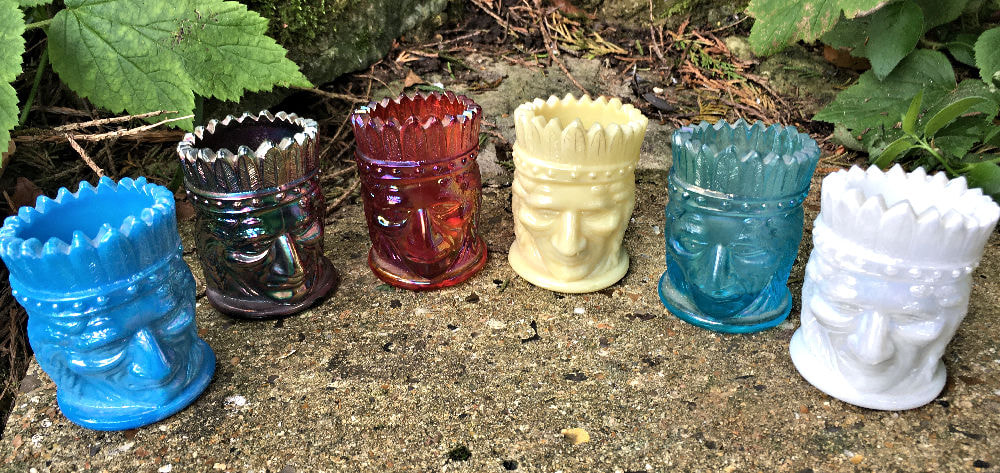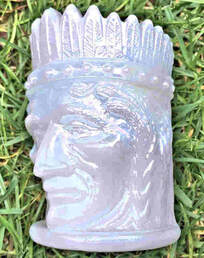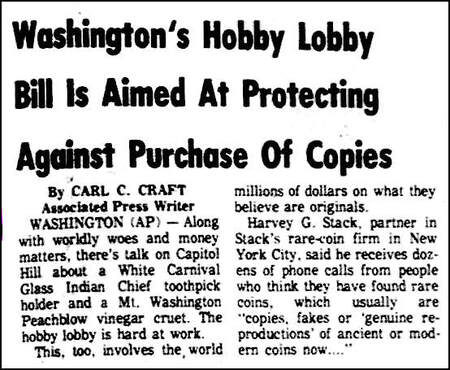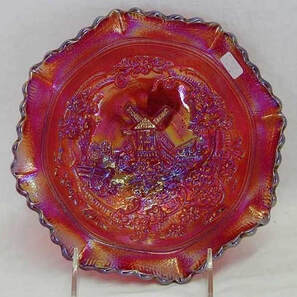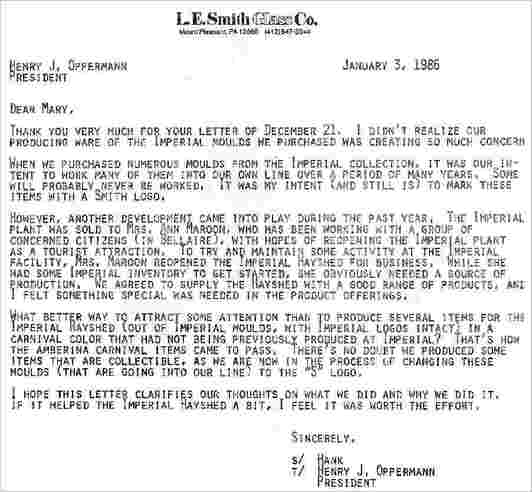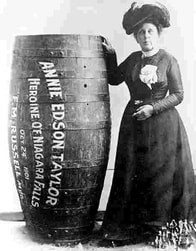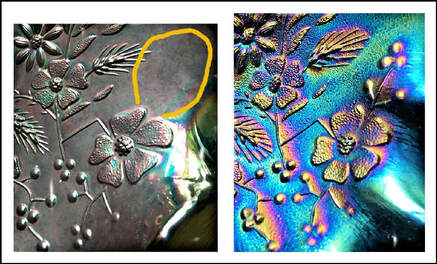NetworK ezine Issue 74. July 2021
Totally Devoted to Carnival Glass
Welcome to our July issue of Carnival Glass NetworK, in which we explore the Carnival Glass Revival. We delve into what might have been and we unearth some surprises along the way. Hold on for a fascinating journey.
|
The Carnival Revival
On June 4th we placed an announcement in our Carnival NetworK Group on Facebook, explaining that we would be introducing the term “Carnival Revival” into our work, instead of (but sometimes alongside) the familiar, previous term “Contemporary Carnival”. We felt that, with the passage of time, the term “Contemporary Carnival” was losing its context and its relevance. “Contemporary” describes something that is current and in the present; it refers to the “here and now”, and the word simply feels inappropriate for such a long period of time: after all, it is around 60 years since the first Carnival re-issues appeared in the 1960s, and many collectors today weren’t even born then! We define Carnival Revival as the era from the 1960s to date, embracing the time from when the first re-issues appeared in the 1960s, right up to present day production. Imperial Glass ad in The Pantagraph - December 7th. 1967.
There are more Imperial ads like this here: The Story of Imperial's Carnival Revival |
Above: detail from Fenton’s Mermaid Planter – it was made from a Verlys mould acquired and modified by Fenton.
The 1960s saw several of the Classic Carnival makers, such as Imperial, Fenton and Westmoreland, revive many, well-loved, old patterns in a fresh-look Carnival. In fact they referred back to the "old" production in their marketing and promotional literature (as in the Imperial ad on the left). Other makers such as St. Clair, Smith, Mosser and more, soon followed. Of course, the term “Contemporary Carnival” is currently used in many books, websites and other resources (including ours) which is why we will continue to use both terms when needed or for context. |
Reissues, Reproductions, New Patterns and Fakes
It’s complicated, but let’s try and make it more simple.
From around 1907, Classic (old) Carnival Glass was made – sometimes fresh patterns were created for the “new” iridescent glass, such as the amazing Rose Show pattern (below, right) made by Northwood). However, often older patterns (that were already in use and being made in other kinds of glass) were trialled in the "new style" iridescent glass. Moulds were expensive, and no doubt glassmakers wanted to test the public's reaction and demand for the new style glass before investing in more of them.
It’s complicated, but let’s try and make it more simple.
From around 1907, Classic (old) Carnival Glass was made – sometimes fresh patterns were created for the “new” iridescent glass, such as the amazing Rose Show pattern (below, right) made by Northwood). However, often older patterns (that were already in use and being made in other kinds of glass) were trialled in the "new style" iridescent glass. Moulds were expensive, and no doubt glassmakers wanted to test the public's reaction and demand for the new style glass before investing in more of them.
|
Of course, the glass was a huge hit and it sold well. There was a veritable explosion of new patterns, shapes and colours for a very receptive buying public. A few decades later (from the 1940s) it started to be collected in an organised way, for its intrinsic beauty. |
Northwood’s Classic Carnival Rose Show bowl in purple.
Early pioneer collector, Phil Garrison, reported how he was “picking up Rose Show pieces for 25 cents apiece” for his collection, in the 1940s. Left: this 1912 Imperial Catalog image shows the large berry in four different iridescent colours: Rubigold, Azur, Helios and Old Gold (now respectively called marigold, amethyst, Helios and amber). Catalogue image courtesy Jon D Bartell. |
The pattern continued in other forms, colours and from several different makers over a further fifty years! Lennox Imperial and Arthur Lorch Imperial (LIG and ALIG respectively) both made items in the pattern.
Following the final closure of the factory, and subsequent sale of all Imperial moulds, L. E. Smith and Summit used them to make Carnival reproductions in a variety of shapes in the old Imperial “American Beauty Rose” pattern.
Reproductions of this pattern were also made later by Fenton. In their June 2010 newsletter (illustration from it shown below on the left), they explained; “The mould used to make this basket originated at Imperial Glass in Bellaire, Ohio, about 1910. Many collectors call this pattern American Beauty Rose.”
Following the final closure of the factory, and subsequent sale of all Imperial moulds, L. E. Smith and Summit used them to make Carnival reproductions in a variety of shapes in the old Imperial “American Beauty Rose” pattern.
Reproductions of this pattern were also made later by Fenton. In their June 2010 newsletter (illustration from it shown below on the left), they explained; “The mould used to make this basket originated at Imperial Glass in Bellaire, Ohio, about 1910. Many collectors call this pattern American Beauty Rose.”
|
The full story of "American Beauty Rose" is here: Imperial's American Beauty Roses
There is one final twist on the story of this pattern, in the late 1920-early 30s, the Finnish maker Riihimaki made small Carnival plates in a delicate pink glass, in a perfect copy of the Imperial Beauty Rose design. We have called this pattern Riihimaki Open Rose in recognition of its Imperial origin. |
Fakes are entirely different to Reissues and Reproductions: Fakes are intended to deceive and although made in more recent times, they usually imitate old Classic Carnival. Items including popular patterns such as Peacocks, Good Luck, Butterfly & Berry and Stag & Holly have all been faked. We'll return to this in future issues of NetworK.
New patterns are an important part of Carnival Revival production.
Realising that the newly-made Carnival Glass was very popular, many glass makers have produced a wide range of novelties and completely new and original designs, that continue to this day.
Revival / Contemporary Carnival in new patterns and shape. Left to right: a Fenton novelty Snail in blue,
a Wheatoncraft "Paul Revere" paperweight in an aqua blue shade, and a collage of Sun Tiles in various colours made by John Cook Studios.
a Wheatoncraft "Paul Revere" paperweight in an aqua blue shade, and a collage of Sun Tiles in various colours made by John Cook Studios.
Articles that appear in Dusty Places
|
It sounds like a line from Stephen King’s “Needful Things” – the horror novel about a dark and dusty antique shop with hidden rarities like a Carnival lampshade or a rare baseball card. In fact, it was a quote from a representative in the U.S. Congress, during a discussion centred on a proposed Hobby Protection Act, back in the early 1970s. Here’s what was said: “there is a genuine need to imprint upon articles … that appear in dusty places with the impression of having been made long ago, the date when they were made so that … there should not be a deception”. In Network (#73) we included another intriguing quote: "Along with worldly woes and money matters, there's talk on Capitol Hill about a White Carnival Glass Indian Chief toothpick holder". |
So now we bring you the full story of what might have been … what could have changed the world of Carnival Glass collecting, what could have affected all those “antiques” in dusty places.
The Hobby Lobby
Pause for a thought that many of us have considered – if only all Carnival was trademarked, or perhaps dated, how much easier identification would be. We know that almost all the old Classic Carnival was not marked; Northwood's "N" mark appeared on a lot of their Carnival (but not all of it), and other Classic marks that were sometimes used include Imperial's "Iron Cross" and "NUART", and Cambridge's "NEAR CUT". Other makers that marked some of their Classic Carnival include Riihimaki, Sowerby, Eda and some glassmakers in India.
It’s fair to say that a lot of Revival Carnival does have some kind of maker’s mark – but crucially, much of it is not marked, or has a mark from the previous owner of the mould, not the current actual maker. All of which can be very puzzling.
But there was a moment, back in the 1970s, when it could all have become very different indeed. A bill was being debated in the USA which might have resulted in a totally different situation for collectors. Called the Hobby Protection Act, it was aimed at requiring all newly made items within the scope of the legislation to have a maker's mark and/or be dated, and in its early stages there was a lot of discussion about Carnival Glass.
|
The 1973 “Associated Press” extract on the right notes that the talks were focussing on a “White Carnival Glass Indian Chief toothpick holder”. The item in question was made by Joe St Clair and it was being talked about because it was an unmarked $2 new piece (made in 1968) that had been passed off as an old item and sold for $50. (Note: an inflation calculator suggests that $50 then would have a purchasing power of around $300 today). Here is a white (lightly iridised milk glass) Indian Chief toothpick by Joe St Clair. This one is marked on the underside of the base "Joe St. Clair" in script.
|
1973 “Associated Press” extract
|
The expectation was that, by requiring all new items to be marked/dated, newly made Carnival would not be mistaken for old (Classic) production, and that reproductions and fakes would be more easily identified. But it was not to be. The Act was passed, but the legislation was limited to protecting political and numismatic items only. Glass was not included.
We researched this in depth and authored an article in 2015, which you can now see on our website in an expanded form. All the details and background, as well as many fascinating extracts from the Senate Hearing, can all be seen.
Here is the full story and it makes very interesting reading. It also gives a great insight into the state of Carnival Glass collecting in the early 1970s: The Story Behind the Glass: the Hobby Lobby
|
Post Script on Trademarks
A lot of Revival Carnival is trademarked – most of that from Imperial and Fenton is marked, as is Boyd’s. Other makers such as Summit, Smith and Mosser are sporadic – some is marked, most isn’t. Westmoreland marked most of theirs, but confusingly old Westmoreland marks were often left on items made subsequently by others. It’s not a straightforward situation, and we came across a most interesting piece of correspondence in a 1986 edition of Dorothy Taylor’s Encore journal that showed just how complex it can be. A number of Carnival items had been purchased at the Imperial Hayshed sale in colours that Imperial had not produced. Furthermore, some of these were not even trademarked. It seems they had all been made by L. E. Smith, and none were marked with the Smith "S" logo. In fact, some still had the IG (and LIG or ALIG) marks on them. Hank Oppermann (the President of Smith Glass) responded as shown here on the right. |
True to their word, L. E. Smith began to change the Imperial marks for their own. On the left is a red Carnival Windmill bowl, a pattern easily identified with both Classic and Revival / Contemporary Imperial production. In fact it's a reproduction, made by Smith from the Imperial mould and marked with Smith's " S " on the base. Picture courtesy Seeck Auctions |
So, remember, sometimes those trademarks are not telling the whole story (or may be telling a totally different story)!
We will return to this theme in the next issue of NetworK - it was clearly a hot and contentious topic back then, and to some extent, this has continued through to the present day.
What happened to the attempts to keep Imperial open?
In his letter (above) Mr Oppermann referred to the "hopes of reopening the Imperial plant" - but what became of this?
Readers of our previous issues of our NetworK ezine will remember the story of the brave attempts to keep Imperial alive (which sadly ended in closure). The story of the Save Imperial Committee (with its "SIC" mark) and also the Pioneer Glass Company were revealed to readers here, thanks to invaluable information that members of NetworK (here and in our Facebook Group) freely shared, for the benefit of the Carnival Glass community.
Here are the stories:
Lions Foot and the Save Imperial Committee
Pioneer Glass Company
We will return to this theme in the next issue of NetworK - it was clearly a hot and contentious topic back then, and to some extent, this has continued through to the present day.
What happened to the attempts to keep Imperial open?
In his letter (above) Mr Oppermann referred to the "hopes of reopening the Imperial plant" - but what became of this?
Readers of our previous issues of our NetworK ezine will remember the story of the brave attempts to keep Imperial alive (which sadly ended in closure). The story of the Save Imperial Committee (with its "SIC" mark) and also the Pioneer Glass Company were revealed to readers here, thanks to invaluable information that members of NetworK (here and in our Facebook Group) freely shared, for the benefit of the Carnival Glass community.
Here are the stories:
Lions Foot and the Save Imperial Committee
Pioneer Glass Company
|
A "barrel of fun"? Maybe not...
The first person to go over Niagara Falls in a barrel ... and survive, was Annie Edson Taylor in 1901 (see right). She said afterwards: “If it was with my dying breath, I would caution anyone against attempting the feat ... I would sooner walk up to the mouth of a cannon, knowing it was going to blow me to pieces than make another trip over the Fall.” Surely there cannot be a connection to Carnival Glass, can there? Check out our next issue of NetworK! Facebook NetworK Group helps to spot Fakes!
Here is a very useful hint on how to spot the Good Luck fakes. This interesting “tell” was revealed on our Facebook NetworK Group by Mike Brown, who pointed out that there is an element missing on the fakes. Here’s what Mike wrote: “The original fake Good Lucks have the buds missing that emerge from the top of the flower at 4 o'clock position on the bowl. There should be 5 buds here. There are some that have only 3 buds but these seem to be quite rare.” |
|
In the photos on the left we show a fake on the left, with the area of the missing buds circled in yellow, and the identical section of the genuine Good Luck bowl, with the buds in place. Remember it's at the 4 o'clock position of the pattern. There are other ways of spotting the fakes, of course, but this is a neat way to clinch the matter. |
If you have missed any of the previous issues of NetworK and NetworK Specials, they are all here: Back Issues.
Privacy and the use of your information: we only use your name and email address to send you your FREE Carnival Glass NetworK ezine. We will not share your name or email address with anyone else, or use it for any other purpose. You can change your mind about receiving your NetworK ezine at any time by clicking the unsubscribe link at the foot of every issue, or by emailing us at [email protected]
Join us on Facebook
We would love you to come and join in the fun, and we invite you and your friends to join us all on NetworK's fast growing and very active Facebook Group!
We would love you to come and join in the fun, and we invite you and your friends to join us all on NetworK's fast growing and very active Facebook Group!

